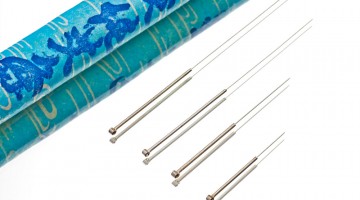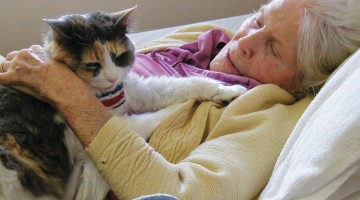Busy kitties – A fascinating glimpse into the world of working cats
Think of working and therapy animals and it’s most often dogs that spring to mind. Dogs have long received most of the credit for their dedication and service, but there are a lot of fantastic felines out there who deserve just as much of the glory!
You wouldn’t think these independent, sometimes finicky creatures would be inclined to serve humans or other animals, and it’s true that most don’t. But some unique kitties excel at it and do their job just as well as any canine.
The Algonquin Cat
You’ve probably met cats who act as “doorkeepers” at retail stores or veterinary clinics. They collect as many strokes and pats as possible during the course of the day but for the most part melt into their surroundings and live a quiet existence.
Not so Matilda, the Algonquin Cat. As the current successor in a long line of four-footed feline greeters at the upscale Algonquin Hotel in mid-town Manhattan, Matilda spends her days interacting with visiting luminaries and society’s elite.
Known as the home of the $10,000 martini (the ice is a diamond), the Algonquin has accommodated many famous people over the years, including Diana Ross, Anthony Hopkins, Rudy Giuliani and William Faulkner. All have been greeted by the Algonquin Cat, whose legacy dates back decades.
It all began one day in the 1930s, when an unkempt stray cat walked into the hotel and adopted it as his home. The hotel’s original owner, Frank Case, treated the cat as he did any other guest, with respect and kindness, and allowed the cat to remain. Guests loved the addition of a “kitty concierge” and a tradition was born. As the story goes, the Algonquin Cat is so adored that travelers from all over the world choose to stay there; for some, it’s a decision based mainly on knowing they can indulge in some kitty company. Matilda, the current Algonquin Cat, is so popular that she has her own email address and receives messages from admirers all over the world!
Feline thespians
As early as pre-Shakespearean days, theatre-goers in Britain became accustomed to the presence of a resident cat. Originally, cats were brought into theatres to control rodents but they very quickly proved they were more than mere mousers. They diverted audiences by making unrehearsed stage appearances, helped calm the nerves of cast members struck with stage fright, and were thought to be lucky charms. Some believed that if a cat left a deposit in your dressing room, you would go on to great success!
Even today, cats are a part of theatre life, sometimes with unexpected consequences. Always willing and able to provide a disturbance or two, a bold young man named Boy Cat who lives at the Albery Theatre once ate Princess Margaret’s bouquet during a Royal Gala performance. (Who says cats don’t have a sense of humor?)
Cats also work on film and television. Some of the more famous feline names include Salem, from Sabrina the Teenage Witch, Mr. Jones from Alien, Snowball from Stuart Little and the hilariously curt, no-nonsense Sassy from Homeward Bound, the Walt Disney remake of The Incredible Journey.
What exactly makes a cat suitable for acting? A face the camera loves is a good start but he also needs to have personality, stability and a willingness to learn and work. Dana Dube of Animal Insight, a company in British Columbia that provides animals for film and television, says cats are motivated by treats, toys and praise. The challenge is that most cats are sensitive to new environments and people. Cats who work in film must be exceptionally confident and trusting; they must enjoy being the centre of attention and quickly settle into new places.
One of Animal Insight’s feline stars is Billy, whose credits include the feature films I, Robot and The Exorcism of Emily Rose. Dana says Billy genuinely enjoys being on set and takes pride in doing a good job. He’s a show-off and his favorite reward is when the cast and crew join in on his praise. It seems he did such a good job on I, Robot that leading man Will Smith gave him his chair!
Therapy cats
Some cats may never become a celebrity in the Hollywood sense, but those accredited as therapy cats are big stars too. According to Judith Dremin, Director of Evaluators for Therapeutic Paws of Canada (TPOC), these four-footed therapists are the true ambassadors of the feline world.
Not many cats are suited for this type of work – for example, only six are certified with TPOC. Before a cat can qualify, both he and his guardian must go through an in-depth evaluation and stringent testing. Once they meet the protocol, therapy cats and their human handlers make regularly scheduled visits to patients in hospitals, long-term care facilities and nursing homes.
Not only do therapy cats provide comfort, companionship and unconditional love, they can also play a role in assisting with a patient’s recovery. Research has shown that interaction with an animal decreases stress and blood pressure. Stroke patients may show improved motor skills simply from the exercise of petting the visiting cat. Speech may also improve as the patient sounds out the cat’s name or offers words of affection. A depressed patient may become less withdrawn simply by interacting with the cat.
A good example is the relationship shared by Quill and Carolyn. Quill is a three-year-old blue point Siamese who regularly visits Carolyn, a resident in a long-term care facility. Carolyn can no longer use her hands to play her beloved fiddle, but through Quill has found another use for her hands and another love in her life. According to Quill’s “mom” Jane Sievenpiper, he is not a natural cuddler. Quill chooses who he sits with, so when he picks you, you know you are his special friend. Such is the bond between Quill and Carolyn. He happily sits on the tray of her wheelchair and goes for a ride as she beams and looks proud. Carolyn has been given a new sense of importance and belonging because Quill has chosen her as his special companion.
Oscar’s amazing gift
Some cats enhance their therapeutic skills with what seems to be a seventh sense. One amazing example is Oscar, whose story made media headlines and was published in the New England Journal of Medicine last year.
Oscar lives at a Steere House Nursing and Rehabilitation Center in Rhode Island. Normally an aloof, stick-to-himself kind of guy, Oscar will occasionally settle on the bed of a resident and doesn’t leave until that person has passed away. The staff soon recognized that whenever Oscar did this, it meant the resident was close to passing. Oscar’s uncanny and apparently stellar record for predicting the demise of residents not only better prepares the staff, but gives them time to alert the relatives. Family members are grateful for Oscar’s ability and appreciate the comfort he gives all those involved.
Oscar was recently awarded a wall plaque commending his compassionate hospice care. All working cats deserve this kind of recognition. Whether they’re performing for the camera, greeting visitors, or bringing comfort to those in need, these unique and hard-working felines enrich our lives beyond price.
Job qualifications
Working cats should be:
- outgoing, amiable and sociable
- happy being with people
- unafraid of crowds
- quick to adapt to strange people and environments
- 100% non-aggressive
- socially confident and focused
- unfazed by sudden movements or loud noises
- motivated and eager to learn and please, even if it takes a whole lot of treats!






No Comment